Koichi Tanaka on the Mission of Science and Technology

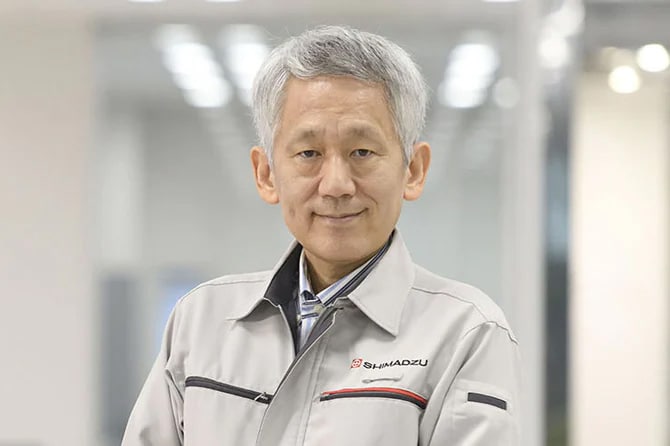
Series: MOMENTUM
Science and technology have brought tremendous progress to the human race. Shimadzu Corporation has been a part of these efforts throughout its history. However, even now, humanity continues to face numerous challenges, and our future is not guaranteed to be bright.
The year 2020 marked the fifty-year milestone since Shimadzu released its first mass spectrometer. Mass spectrometry has played a role in accelerating progress in the life sciences. Koichi Tanaka, a Nobel laureate in Chemistry, an Executive Research Fellow at Shimadzu, and acting as the head of Shimadzu’s Koichi Tanaka Mass Spectrometry Research Laboratory, talked about science, technology and the future of humankind.
(Note: This interview took place in 2020.)
Great Strides in Mass Spectrometry
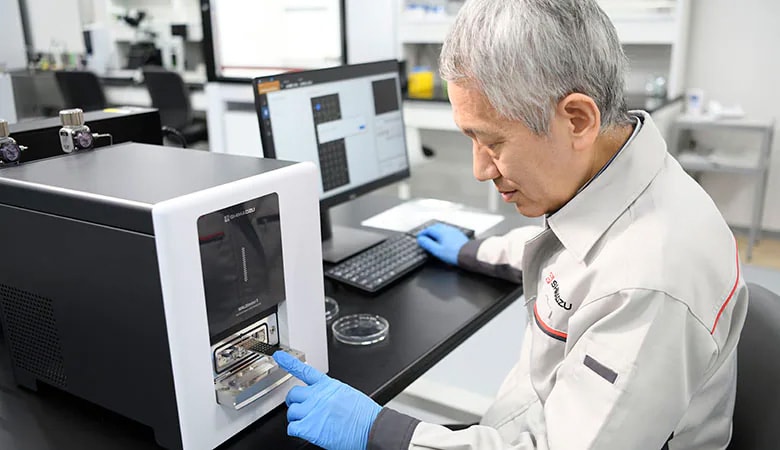
I joined Shimadzu in 1983. Since then, I have been involved in the research and development of an analytical technique called mass spectrometry.
Mass spectrometry generates ions from compounds, separates these ions, and detects them qualitatively and quantitatively, thereby enabling us to quantify known substances and identify unknown compounds in analytes. Mass spectrometry is considered to have been first developed in 1919, more than 100 years ago.
Fifty years later, in 1970, Shimadzu introduced the LKB-9000 to Japan in partnership with LKB, a Swedish company that manufactured the world’s first mass-produced gas chromatograph mass spectrometer (magnetic sector MS). Exactly 50 years have passed since then, so for me this year feels deeply significant.
When I first joined Shimadzu, our flagship product was Shimadzu’s original gas chromatograph mass spectrometer. The system at the time was large enough to fill a room of our laboratory. Today, we manufacture a variety of mass spectrometers, including one the size of a microwave oven, that are more than one hundred million times more sensitive. The resolution power has also significantly improved to a degree that was unimaginable 50 years ago. These advances have been applied in various research, such as: to analyze trace levels of pollutants in the environment, to monitor drug concentration for new drug development, and to reveal the biological mechanisms of diseases not yet well understood.
In addition, matrix-assisted laser desorption/ionization-mass spectrometry (MALDI-MS) has paved the way to ionize and analyze macromolecules such as proteins without destroying them, something that was previously impossible to do. Behind this scientific achievement (*) was a discovery based on my “monumental blunder” in the course of my research searching a matrix that would enable non-destructive ionization of macromolecules by soft desorption ionization methods.
(*) The finding led to the Nobel Prize in Chemistry in 2002.
At our research laboratory, we have worked on a study to search for blood biomarkers to predict amyloid-beta deposition in the brain, which is considered an indicator of Alzheimer’s disease. One reason we followed this line of research was its selection by Japan’s Funding Program for World-Leading Innovative R&D on Science and Technology (FIRST, March 2010 to March 2014).
At first, we were told this research would be fruitless. However, through collaboration with the National Center for Geriatrics and Gerontology and various other leading institutions, my staff and I persisted, building up results step-by-step. In 2018, we finally succeeded in publishing an article in Nature. Our research work is not over with the publication of the article. We still have a lot to do. We still continue to engage in research and development for practical advancements by automating the analytical workflow and increasing the laboratory throughput in cooperation with many partners in industry, academia, and government.
Currently, infectious diseases caused by pathogens are threatening us again. We have been studying how to apply the laser ionization method for microorganism analysis. Using mass spectrometry for infectious disease testing enables the cause of an infection to be determined faster than before. Appropriate treatment can then be provided before the disease becomes serious, and it could help prevent the spread of the infection. Currently, mass spectrometry is being used worldwide to identify the cause of bacterial infections.
Unfortunately, new infectious diseases appear one after another. In collaboration with several related departments within Shimadzu, our lab will be investigating whether mass spectrometry-based identification has potential applications for viral diseases.
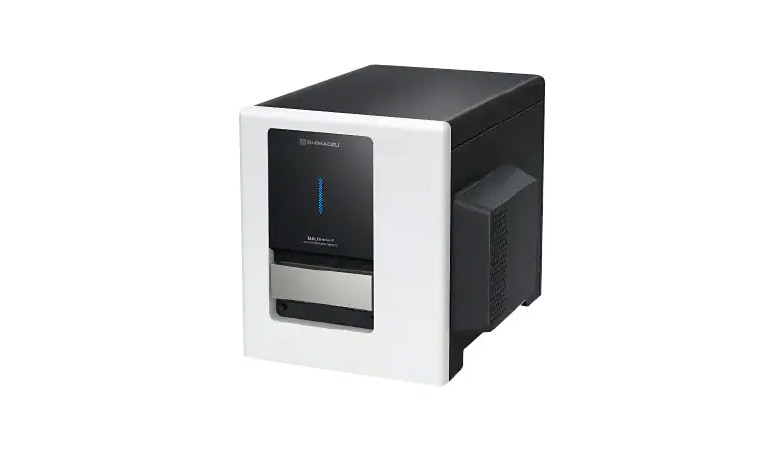
MALDImini-1, the First Commercially Available Compact MALDI Digital Ion Trap Mass Spectrometer
The MALDImini-1 fits in a space the size of a piece of paper, while allowing fast high-sensitivity measurements and detailed structural and qualitative analyses over a wide mass range, even with sub-microliter sample volumes.
What it Means to be Useful
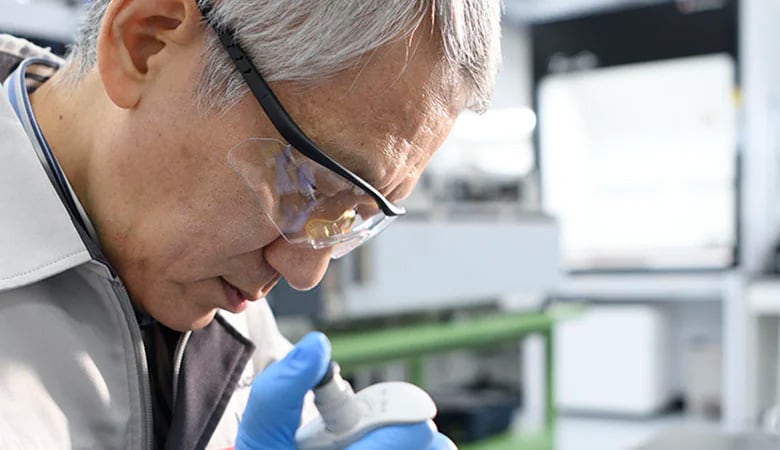
Science and technology have allowed humans to make what was invisible visible, and the knowledge we have gained has been used to create healthy and safe societies. Nevertheless, I am concerned that pure science is still not viewed as a worthy pursuit.
Compared to technological development aimed at commercialization through the practical application of fundamental principles, pure science and its pursuit of basic research, leading to Nobel Prizes, does not produce immediate economic benefits. For this reason, it has been labeled as pointless. But is that really the case?
I believe that science and technology each have a purpose, and both are essential to the continued existence of who we are as people. It is true that technology advances in an attempt to deliver things beneficial to the real world, so it is easy to see how it is useful. However, I see science as having a deeper, more profound purpose.
Progress in science is guided by a sense of curiosity, or the desire to discover what is currently unknown. On the other hand, progress in technology is guided by a sense of public duty, or the desire to be useful to people.
This is the general principle of my approach towards experimentation. In Japanese, the words for “sense of curiosity” (Kou-ki-shin) and “sense of public duty” (Kou-kyou-shin) even sound similar.
In contrast with other animals, humans clearly have a much greater sense of both curiosity and public duty. As a result, we have been able to prosper so well on Earth as a species. Curiosity and public duty have worked in tandem to support human progress, each being essential to the other. In other words, I believe the role of science is to help us continue to be human.
Beyond Human Conceit
Not long ago, the expression “Be Kind to the Earth” became popular. Through many changes and developments, this has evolved into what we now call “SDGs,” though even this concept retains an element of arrogance. I believe this issue requires a wider, more historical frame of view.
SDGs stand for “sustainable development goals.” It is not clear who the goals are for, but they are almost certainly human goals. Principally, to protect the Earth’s environment so humankind can continue to exploit it and live on Earth for generations to come.
In reality, Earth does not care if humans are kind to it. From its perspective, humans are incidental in the grand scheme of things in the universe. In primeval times, cyanobacteria are believed to have released vast amounts of oxygen that wiped out almost all living things. The Earth survived despite this. The popular theory for why humans and other animals flourish today is because the dinosaurs were made extinct by a meteorite impact. And yet, our success represents a tiny footnote in the long history of Earth.
If we are to pursue SDGs, rather than thinking of humans as separate from the natural world, we should consider the idea familiar to Japanese and Eastern cultures that humankind is a part of the natural world and that human-being itself, and even civilization, is a “natural phenomena”, born of the Earth in the broadest sense. I think this framework will help you find goals and milestones that go beyond the concept of SDGs.
All individuals should ask themselves, “What should I do?” We should also keep this perspective in mind when dealing with the current coronavirus pandemic. The world is currently united in fighting to overcome this disease, yet a virus is not something we can eradicate completely. Humankind has survived many infectious diseases, not through eradication but, rather, through coexistence, such as incorporating some of their bacterial and viral genetic information into our genetic code.
As the recent coined expression, “living with COVID-19,” suggests, I think it is best to take the view that we should avoid danger as much as possible while accepting that this will be a long-term relationship.
Innovation Arises from the Meeting of Different Fields and Perspectives
No man is an island, and anybody, including myself, who sets out to achieve their goals alone will only be defeated by their own limited abilities. This is why it is so important for people from different fields and different industries to work together.
In the case of the coronavirus, once the virus spread to epidemic levels, companies and individuals with no previous involvement in medicine or drug discovery proposed one new idea after another. They then collaborated with pharmaceutical companies and manufacturers such as us and produced an array of original innovations and products.
This meeting of people who had never met before and the sharing of ideas outside the bounds of their imaginations created a fertile ground for innovation. Innovation is often interpreted to mean technological reform, but essentially it means “new connections, new perceptions, and new applications.” Defined in this way, innovation seems merely a natural flow of events.
The R&D facility where I now work was built just last year and includes a space on the ground floor designed to be like a salon. People from outside the company have also visited there for discussions, and we have created a work style in which we try to test the discussion in the laboratory by saying, "Well, let's give it a try."
Many people from our engineering and research groups in other buildings have also relocated to this new facility. One of these groups developed our reagent kit for PCR analysis (*). Previously, it was a 15-minute walk to visit this team but now they are less than one minute away. Thanks to this new R&D facility, many colleagues can pursue their research sitting beside each other.
I make it my custom to walk around Shimadzu for work. Before relocating to this facility, I used to walk 4,000 to 5,000 steps a day. Now, I walk over 10,000 steps each day. This count should have become smaller given how much closer I am to my colleagues, but it shows how many more opportunities this environment gives me to meet with different people. The same is probably true for other people, too, and I look forward to seeing how this will turn out in the future.
Allowing Young Researchers the Opportunity to Thrive
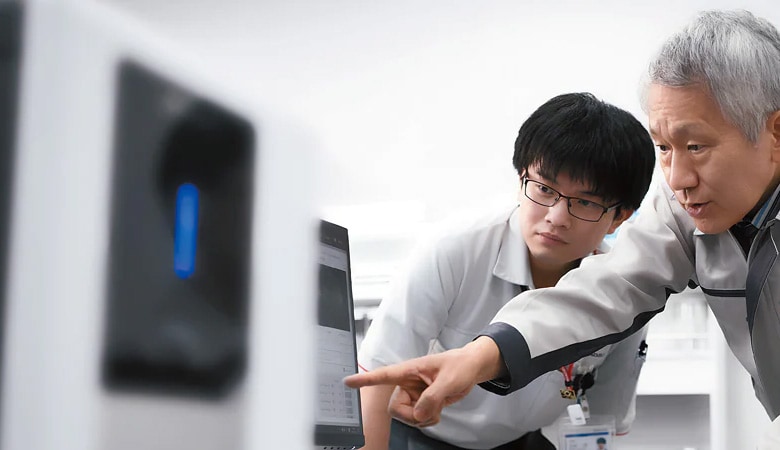
I have led this research laboratory for the past 17 years and, during this time, have also headed a research program under Japan’s Funding Program for World-Leading Innovative R&D on Science and Technology for several years, but I am far from a natural leader.
My approach has been to nudge team members by saying, “That’s interesting. Keep working on it,” or to encourage them by saying, “That might seem like a failure, but perhaps you can use it for another purpose if you try it this way,” when I see them struggle.
I was shy and a poor communicator in my 20s and had trouble expressing myself in social situations. Despite this, my supervisors and senior colleagues recognized my good points and were kind enough to praise and nurture me.
I received encouragement at our monthly presentation in the laboratory, gained confidence at the annual in-house presentation meetings, then began participating in conferences, where I met other mentors who connected me to the wider world. This series of experiences has led me to become the person I am today.
This is why I want young researchers to enjoy their work without fear of failure, as I believe this approach will lead to new discoveries.
My personality has always been contrarian, and I have also believed you cannot keep up with geniuses by thinking in the same way as them. This is why, even if a member of my group makes a mistake and strays away from their goal, I tell them honestly what is good from my point of view.
A research laboratory under a leader like myself has published over 100 papers in 15 years. It shows, I believe, that this approach is not entirely ineffective.
Becoming an Advanced Problem-Solving Nation
Attempting to look at things from a slightly different perspective is actually very important.
I discovered a new method for ionizing proteins when I accidentally added the wrong material to a matrix but tested it anyway because I didn’t want to waste it.
I majored in electrical science at university. If I had studied chemistry at university and had better knowledge in the area at that time, I would probably never have tried using the matrix after adding the wrong material.
To put it the other way around, it was thanks to being outside the field that I discovered the new method. This can be said to be an example of how innovation arises from the meeting of different fields and perspectives.
Japan is called an advanced nation that faces many challenges, such as a declining birthrate and aging population. However, Japan is also an advanced country in terms of solving a number of issues, such as recovering from disasters and environmental pollution.
As we inherit this legacy today, people in all fields continue to collaborate across disciplines, share their wisdom, and work hard to overcome the many challenges we see in front of us. I think we should appreciate this amazing state of affairs and be extremely confident about it.
I have no doubt that the wisdom and enthusiasm directed at overcoming challenges will positively impact the world. Personally, I am continuously committed to putting my own abilities to use as just one researcher among many.
(*) Research Use Only. On September 8, 2020, we obtained approval from the Japanese Ministry of Health, Labor and Welfare for the marketing of "Ampdirect™ 2019-nCoV Detection Kit" for in vitro diagnostics in Japan.
History of Koichi Tanaka Mass Spectrometry Research Laboratory—A Future Made Visible by Ions—
2003
The Beginnings of Koichi Tanaka Mass Spectrometry Research Laboratory
The Koichi Tanaka Mass Spectrometry Research Laboratory (MS Laboratory) is established and began research with a team of six members.
●2006
Prof. Franz Hillenkamp Visit
As a developer and inventor of MALDI, Professor Franz Hillenkamp visited Shimadzu, where he gave a lecture and participated in discussions with engineers and other staff members working in mass spectrometry.

●2008
Delivering a DIT-MS System to Seattle
A scanning-type digital ion trap mass spectrometer (DIT-MS) developed at Shimadzu was flown to Seattle. The system was installed for collaborative research with the Fred Hutchinson Cancer Research Center to search for disease-related O-linked glycopeptide biomarkers. The collaboration led to an article published in Nature Protocols.
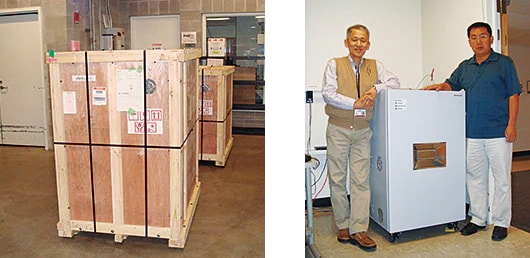
●2010
The Beginnings of Koichi Tanaka Laboratory of Advanced Science and Technology
The Koichi Tanaka Laboratory of Advanced Science and Technology focused on research involving mass spectrometry. It was established for the “development of the next generation mass spectrometry system, and contribution toward drug discovery and diagnosis” (ms3d project), one of the themes of Japan’s Funding Program for World-Leading Innovative R&D on Science and Technology (FIRST). Koichi Tanaka was a principal researcher (general manager) for the FIRST project.

●2011
Release of Mass++ Ver. 2.0
Version 2 of Mass++, mass spectrometry data analysis software was developed as part of the FIRST ms3d project and released as freeware. It allows for loading data from various mass spectrometers and displaying or analyzing the data in various ways.
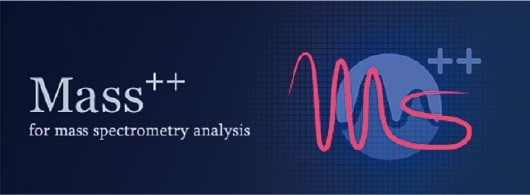
●2014
Research for Discovery of a Blood Biomarker for Alzheimer’s Disease
Collaborative research with the National Center for Geriatrics and Gerontology resulted in the discovery of a blood biomarker that can be used to estimate the cerebral deposition of amyloid-beta, a cause of Alzheimer’s disease.
●2015
ATHAP Released
ATHAP™ was a new matrix used for the high-sensitivity analysis of hydrophobic proteins or peptides. The release of ATHAP™ was announced at ASMS 2015 and sales started the following year. Alkylated trihydroxyacetophenone (ATHAP) has demonstrated superior detection capabilities over conventional MALDI matrices for such proteins/peptides.
ATHAP™ was the first technology commercialized by the MS Laboratory.
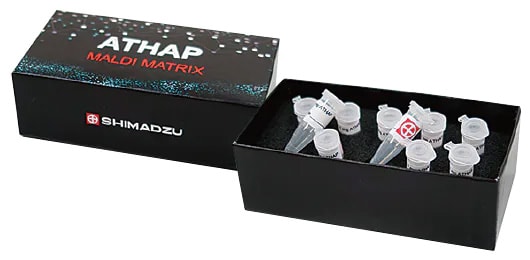
●2018
Over 100 Published Papers
The total number of papers published since the establishment of the MS Laboratory with current or former staff members as leading author or co-author exceeds 100.
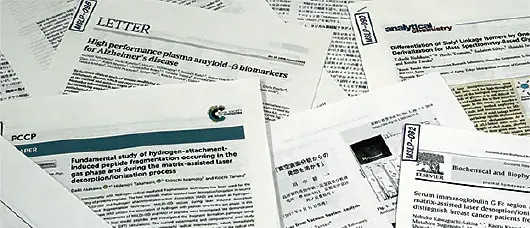
●2018
Research for Early Detection of Alzheimer’s Disease Based on Blood Test
The research for early detection of Alzheimer’s disease was further developed since the discovery of the blood biomarker in 2014, and its efficacy was verified using large numbers of samples from Japan and other countries.
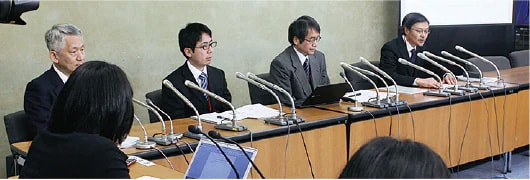
●2019
Commercial Launch of MALDImini-1
MALDI has been a research focus at the MS Laboratory, and the digital ion trap technology was commercialized in collaboration with the Analytical & Measuring Instruments Division. MALDImini-1 allows researchers to perform comprehensive structural analysis in the world’s most compact package.
●2020
The Study about Discovery of Novel Class of Hybrid Lipopeptide Compounds using the HiRID™-MS/MS Technology was published online in Nature Chemistry
As a result of a joint research effort involving the MS Laboratory and the University of Tokyo, a novel class of hybrid compounds comprising lipids and peptides was identified.
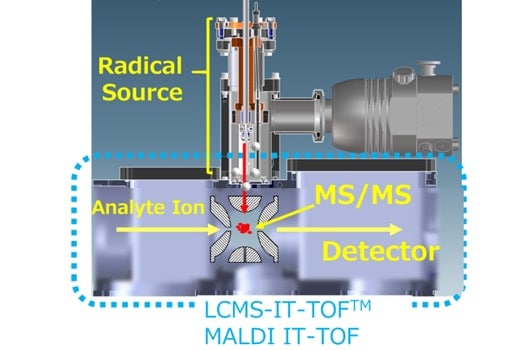
Executive Research Fellow, Shimadzu Corporation
Head, The Koichi Tanaka Mass Spectrometry Research Laboratory
Koichi Tanaka
Koichi Tanaka was born in Toyama Prefecture in 1959. After graduating from the Faculty of Technology, Tohoku University, he joined Shimadzu Corporation. In 2002, he received the Nobel Prize in Chemistry "for their development of soft desorption ionisation methods for mass spectrometric analyses of biological macromolecules". In 2003, he became the head of Koichi Tanaka Mass Spectrometry Research Laboratory which was newly established. From March 2010 to March 2014, he served concurrently as the head of Koichi Tanaka Laboratory of Advanced Science and Technology under Japan’s Funding Program for World-Leading Innovative R&D on Science and Technology (FIRST Program). Since then, he has been engaged in the development of equipment and analytical methods as a corporate researcher and engineer at Shimadzu Corporation.

* This article is an English translation of our article originally published on the website “Boomerang”. The information, including affiliates and titles of the persons in this article, are current as of the time of interviewing.
 Copied
Copied

